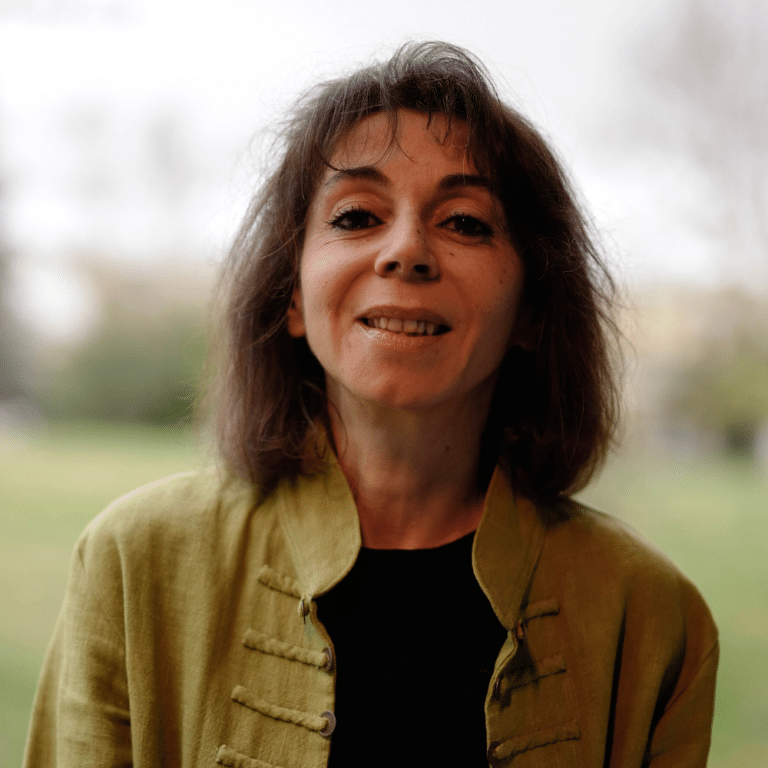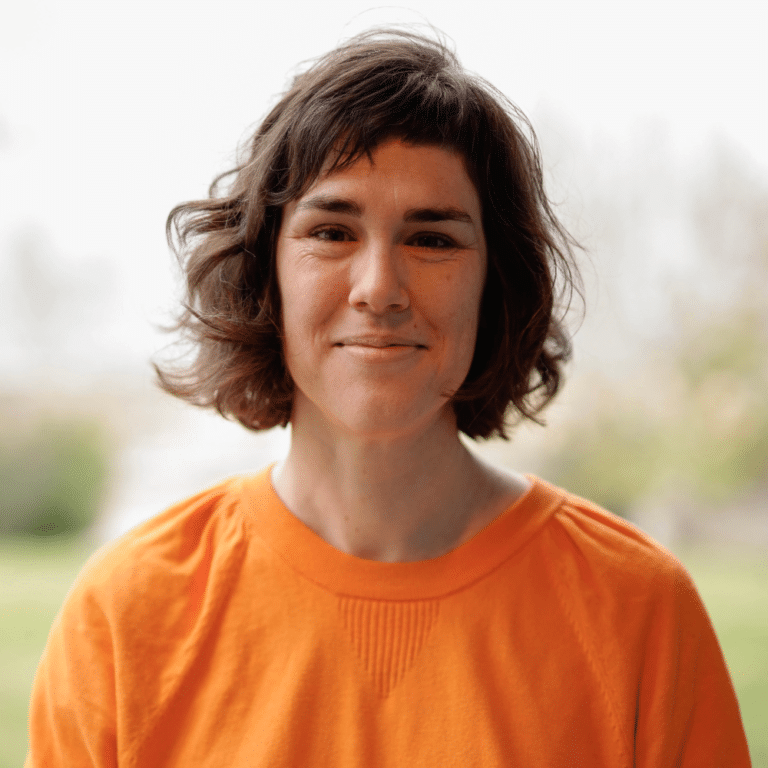
Josune Urrutia Asua
Research project
Thinking Drawing Device
Project summary
Josune Urrutia’s research-creation project Thinking Drawing Device, at Iméra aims to explore the potentialities of drawing as a research tool, epistemological medium and as a place for conversation and exchange.
This research is a continuation of that undertaken during Josune Urrutia’s first residency at Iméra, the Research-Creation in Oncology and Immunology ICI/Iméra Chair, between September 2023 – July 2024.
Drawing as epistemological medium
“In the act of making the non-visible visible, in-sight is made possible.” – Sybille Krämer.
Drawing is part of the daily practice and work of Josune Urrutia. Drawing, doodling, writing by hand, with pencil, pen or brush, mostly alone, but also with others. Inspired by the idea of “drawing as a space of discovery,” as John Berger writes, Josune Urrutia often draws in diagrammatic form, in visual outlines, to understand what she feels, listens and thinks; also, to talk and to communicate with others; and of course, as a memory support and archive, that allows her to go back to moments, experiences, ideas to revisit later.
Tim Ingold considers that “the printing technology broke the intimate link between the manual gesture and the manual inscription,” so we think they are different forms of expression when, in fact, writing is also drawing. In this sense, Sybille Krämer, in her analysis of Plato, who considers diagrams “an indispensable tool for the acquisition of knowledge,” argues that the spatialization and visualization of thoughts are a support for the understanding of ideas. Moreover, she says that “the moment a thought is placed on a surface, the thought takes place. It becomes thinkable, visible, tangible, in space-time.” It happens to be what she calls the “embodiment of the intelligible.”
We know that research is often done with images, with drawings and within the act of drawing as well. It is more common than it seems, even if it does not receive the credit it deserves. Drawing has contributed to the production of knowledge, especially in fields such as botany, experimental sciences, archaeology, mathematics or architecture. Also, drawing has played a significant role in the functioning of the nervous system. Santiago Ramón y Cajal, celebrated as an innovative and pioneering researcher in neurosciences, made important contributions to our understanding of the nervous system with art-science practices that were central to his production of histological knowledge. Indeed, drawing was an essential tool in this case, as it probably is for other research processes nowadays. Drawing is, in fact, a tool for research, thinking and an epistemological medium.
Lastly, a paradigm shift in drawing, moving from “illustrating a narrative with drawings” to “creating a narrative through drawing” could bring new ways of understanding the relations with the world we inhabit and deal with the challenges we are facing today.
The project Thinking Drawing Device aims to address drawing as a medium for research and also as an epistemological vehicle, delving into the following main aspects:
- Drawing/writing distinctions, more specifically about the notion and definition of drawing and writing. The engagement in many cases between words and drawings that work together, due they are not separate elements, and we see them often as a continuity.
- The epistemological aspect of drawing. How thought, listening and understanding occur also through drawing as a practice. The way these procedures are used to investigate, refine complex information and experiences, and how the use of drawing makes it easier to think and understand. Furthermore, how knowledge is structured, and specifically how drawing is part of the nature of scientific knowledge as well.
- Matters related to: Drawing, translation and transcription; Nonlinear thinking and narratives; Perception of drawing; Body, gesture and movement on drawing; and the capacity of drawing as a space for conversation.
Thinking Drawing Device
Thinking Drawing Device is a methodology created by Josune Urrutia to visualize, understand, connect ideas, concepts, and knowledge that arise from dialogue during her first residency ICI/Iméra 2023-24. During this senior fellowship she will further develop and strengthen this methodology as a device, that allows research, listening, thinking exchange and conversation.
The act of thinking, while drawing, helps to bring light, and key elements emerge. Words take their place, while the emotion they evoke is crystallized on the surface through drawing.
Thinking Drawing Device: Research on Cancer is the culmination of a research and creative process within the framework of the Research-Creation in Oncology and Immunology-ICI/Iméra Chair through the programs Interdisciplinary Explorations and Art-Sciences: Indisciplined Knowledge of Iméra. The Institute of Cancer and Immunology (ICI) brings together individuals, teams, hospitals and companies working in the field of cancer and immunology research in Marseille. The initial proposal of this project was to create graphic narratives for scientific and medical evolution on cancer. For this purpose, Josune Urrutia met several scientific researchers and professionals at the Marseille Cancer Research Centre (CRCM), the French National Centre for Scientific Research (CNRS), the Immunology Centre of Marseille-Luminy (CIML), the Marseille Developmental Biology Institute (IBDM) and the French National Institute of Health and Medical Research (Inserm), among others.
Iméra Visual map
In parallel and as part of her research project, on the basis of the Thinking Drawing Device: Research on Cancer, Josune Urrutia will try to capture and visually weave through drawing some aspects of the origins, history and of the framework, spirit of Iméra, with the personal vision of the fellows (expectations, dreams, how people arrive, evolve and finish the experience).
She will research on the potentials of interdisciplinarity to be defined through meetings and encounters with the Iméra scientific team and interviews with the residents. The content will be developed out of what will happen in the regular Community-Building Seminars, the common living spaces and the specific interviews with current fellows, ancient fellows, and anyone else who might be interesting to include.
The purpose is to create a visual product (visual map, diagram, drawings) about/for Iméra, to help promote the value, uniqueness/specificity, of Iméra and to explain its essence, grounds and spirit.
Biography
Josune Urrutia Asua (Bilbao, 1976) is a visual artist mostly focused on drawing and comics. Her research and artistic practice explore graphic narratives, in particular the potentialities of drawing as a research tool, epistemological medium and as a place for conversation and exchange.
Since 2014 she has developed several projects around the subject of art, health-illness with the aim to explore and visualize different points of view on the complexity on cancer. Some of these works are: Así me veo (2015), Breve diccionario enciclopédico de MI cáncer (2017), Compendio colectivo sobre cáncer (2018), Crónicas complejas (2021) and her first graphic novel Hoy no es el día (2022) published in french as Ce n’est pas encore le jour (2024) and Italian as Non è questo il giorno (2024).
Josune Urrutia is interested in those projects where, together with others, we explore and analyze the potential of art to broaden epistemological approaches. In other words, on how artistic practices contribute to the understanding of the world, of life, to make connections and also create knowledge, why not in scientific knowledge too?
She collaborates in art-science projects, mostly with researchers in social sciences and specifically in environmental studies, in order to open interdisciplinary spaces of conversation and creation of knowledge to deal with the current social, political and environmental challenges we need to face. Some of these groups are the Basque Centre for Climate Change (BC3), Shared dialogues, One Planet Shipping and Imagine adaptation.
She contributed to comic anthologies such as: Ecotopías. Imaginar el futuro para cambiar el presente (2023), Tupust! (2021), Efectos secundarios. 19 historietas del covid (2021) and Votes for Women: The Battle for the 19th Amendment (2020).



